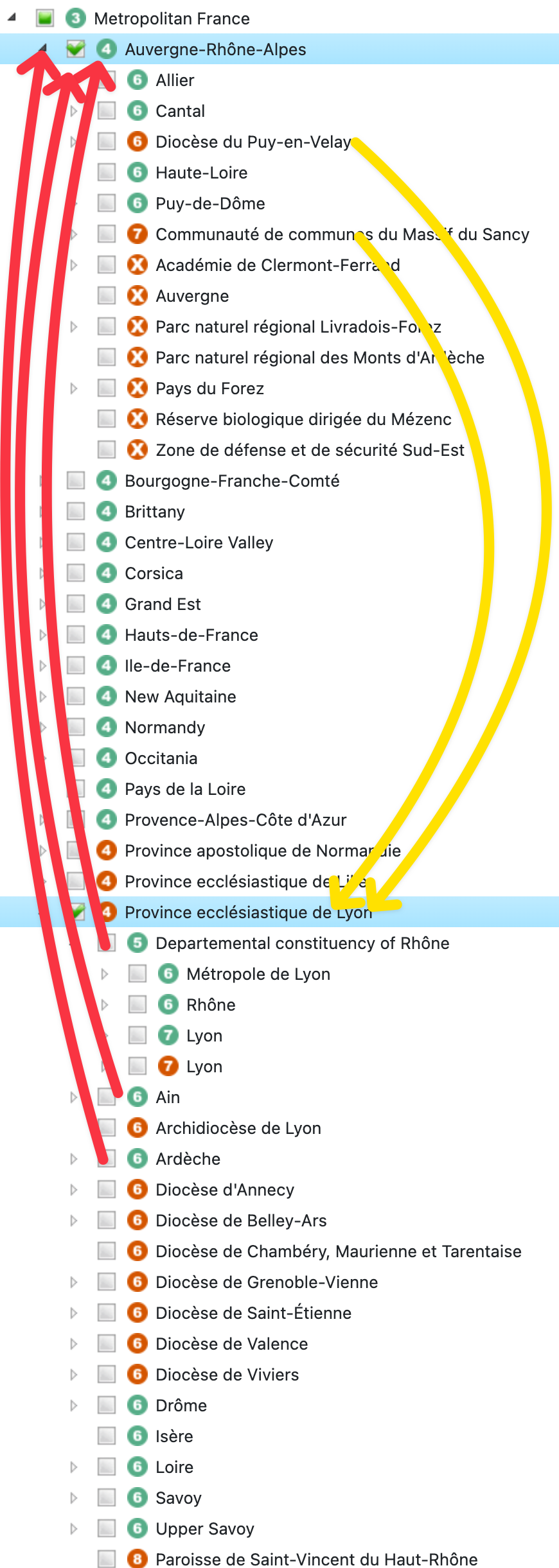Dealing with tree hierarchy of non-administrative boundaries
Besides using the boundaries themselves, I use the data from the tree on the left.
My first comprehensive usage of OSMB was in Q1 2021, when mostly administrative boundaries were part of the dataset.
Now (and since quite a while), there are many others, e.g. region, religious_administration, etc..
While this is mostly nice, I have some issues now, so I'm asking the community how you're dealing with it.
So, there are e.g. "region" boundaries like Klagenfurt-Villach (-2754657), inside Austria/Carintia which I can simply skip and go directly to their children which are again administrative. So far all good.
There are however issues with e.g. some (mostly religious) boundaries which receive children which should be in another administrative boundary:
E.g. Province ecclésiastique de Lyon (-14059783) is in Metropolitain France and almost in Auvergne-Rhone-Alpes (-3792877) but not fully, there's a tiny extension in the center north. I understand why it's thus not inside but parallel, all fine.
However, the administrative boundaries which should (IMHO) end up in Auvergne-Rhone-Alpes (-3792877, administrative) end up in Province ecclésiastique de Lyon (-14059783, religious).
Finally the question itself:
Is there any way (in the UI, from the tree JSON data, ...) without using a complex Poly-in-Poly detection, to move the administrative sub-boundaries into their matching administrative boundary?
Visually speaking: I want children green icons preferably inside green-icon parents, not in red-icon siblings of the parent, see red arrows in the attached screenshot. Similarly (but not relevant for me), the religious Dioceses and Communities could be inside their specific parent (I wanted to show that with the yellow arrows but only later saw, that the yellow arrows are actually wrong because those children are NOT inside the region the arrows point to.




Thank you for this very helpful service, which I point to from my uMap tutorials. and get (non-tech) people to use when I train them to uMap.
My suggestion to this issue (although I have no idea how easy or difficult this would be to implement) would be, for each country, to produce one hierarchy for each value of the boundary tag. Thus the administrative hierarchy would match boundary=administrative, the religious hierarchy would match administrative=religious_administration, and so on.
The tag administrative=local_authority is slightly annoying, as these are generally below the "département" level (admin_level=6) though they may overlap two of them. There are probably similar cases, so maybe a compromise would be to produce the main hierarchy using boundary=administrative, then insert other boundaries within that hierarchy using the current algorithm.
Regards and thanks again for this useful service.
@antoine riche
Sounds like a very reasonable suggestion. At least for some of the values of the boundary tag. Since OSM allows any text string there could potentially be a lot of unique values.
We will at some point implement different hierarchies. When you see that this has been implemented and you don't see your suggestion there, feel free to remind us. At the point where we have implemented support for multiple trees it will hopefully be fairly easy to add yet another variation.